PALAIS GALLIERA – THE PARIS MUSEUM OF FASHION

A stone’s throw from some of the most prestigious haute couture houses and designer boutiques in the city, the Musée de la Mode de la Ville de Paris is housed in the Italian Renaissance-inspired Palais Galliera. The museum preserves some of the richest collections in the world, estimated at around 200,000 items of clothing, accessories, photographs, drawings and more. Tracing the evolution of fashion over more than 300 years, these extraordinary collections are a window into the dress codes of France from the 18th century to the present day, and are regularly accessed for numerous exhibitions in France and other countries.

Since the summer of 2021, the collections are presented for the first time in permanent exhibitions, most of which had never before been seen in France, presenting a history of fashion ranging from little-known pieces through to masterpieces. We are now able to discover the evolution of fashion over more than 3 centuries and follow the development of the silhouette, from the so-called ‘flying’ dress of the 1730s to the avant-garde creations of Comme des Garçons in our own era.

The first presentation, or display, highlighted the history of the Palais Galliera and celebrated the 100th anniversary of the foundation of the collections, which started in 1920 with the donation to the City of Paris of more than 2,000 items by the Société de l’Histoire du Costume (SHC) that had been created in 1907 by Maurice Leloir.
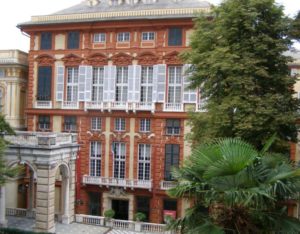
The founder of the Palais, Marie Brignole-Sale, who became the Duchesse de Galliera, was born on 05 April 1811 in Genoa into an aristocratic family that had given the city numerous doges, senators, ambassadors and poets. She received an enlightened education, unusual for a girl in those times, which was enhanced by regular trips with her father on his diplomatic missions—he had been appointed Prefect of the Ligurian Republic by Napoleon Bonaparte, and went on to become the Sardinian ambassador to France, where he was held in high regard by King Louis-Philippe. Marie was, in effect, raised at the Palais de Tuileries with Louis-Philippe’s children, to whom she remained deeply attached.
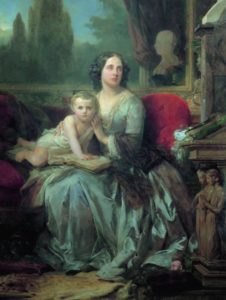
She married the Marquis Raphaël de Ferrari in 1828 with whom she had 3 children. She and her husband acquired the Galliera estate on the river Reno in Emilia-Romagna, and Napoleon made the estate a duchy. Even after the defeat of Napoleon, when the title reverted to the Church, the Pope bestowed it on the Ferraris in 1838, and Marie, Marquise de Ferrari, decided to be known as the Duchesse de Galliera.
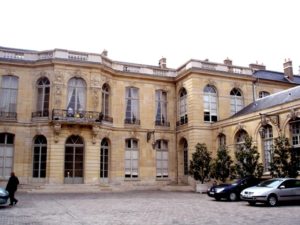
She and her husband were regarded as the wealthiest people in the Empire, able to purchase mansions, palaces and land at will. One of their acquisitions was the Hotel Matignon in Paris, the former hôtel particulier of the Duc de Montpensier, that is now the official residence of France’s Prime Minister. When she was widowed at the age of 65, she found herself in possession of a fortune of 225 million gold francs (her eldest son having spurned the family titles and fortune), which she began to spend on numerous charitable works, as well as a gift of one million gold francs to help establish the École Libre des Sciences Politiques, now the famous ‘University Sciences Po’.
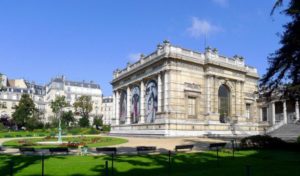
On 15 April 1878, the Duchesse de Galliera made it known that she wished to leave her art collection to the French nation, on the condition that it be exhibited in a specially built museum. The art collection had begun with her ancestors in 1623, when Van Dyck painted a family portrait, and was constantly added to by subsequent generations. It was a distinguished and varied collection, including Flemish, Spanish and Italian paintings, 18th century French furniture, priceless clocks and other items from the Sèvres and Gobelins manufactories—in fact, all the great names were represented.
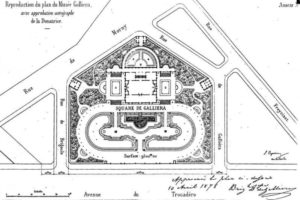
The duchess proposed financing such a museum, to be built on a large plot of land she owned in Paris, near the Trocadero. Her instructions were clear: the museum was to be set in a square with specially created streets on both sides, to be named Rue Brignole and Rue Galliera. The museum itself was to be named Brignole-Galliera.
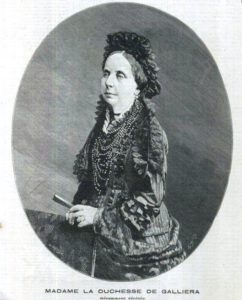
On 11 July 1878, the City of Paris Council gratefully accepted her proposition, and on 31 October of that year, she duly formalised the donation. One stipulation however, was that she would retain possession and occupation of the museum and its outbuildings during her lifetime—their use would only revert to the State on her death.
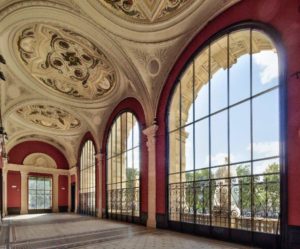
The project had setbacks almost from the start. No sooner had work begun than it was almost brought to a halt by a question of alignment of the buildings. Although this problem was resolved, it brought to light a major error on the part of the Notaire (lawyer) who had drawn up the papers. He had stipulated the City of Paris as the beneficiary, whereas the duchess had intended the gift to be for the French state. Repeated attempts to rectify the error proved fruitless and the situation was not helped by the political climate of the time.
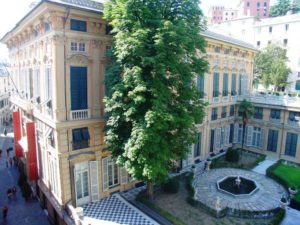
Frustrated, on 07 October 1884 the duchess took the radical step of bequeathing her considerable art collection to the Palazzo Rosso and Palazzo Bianco in Genoa, which meant it would not be shown in the Palais Galliera. The Duchess did agree though to finance the completion of the building, which would at once become the property of the City of Paris. Her death on 09 December 1888 at the age of 77 halted the building works, already well advanced. The works were restarted by the architect Paul-René-Léon Ginain and finally completed on 27 February 1894.
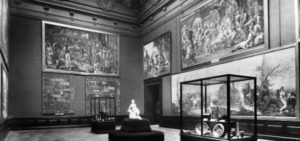
Reactions to the new museum were mixed. Some journalists spoke warmly of the duchess’s philanthropy and of the square itself, but the museum was generally criticised as being too small and unsuited both to an extensive collection and large exhibits. The question then was: what to do with this elegant building lacking the collection originally intended for it, that was now a kind of empty jewel box?
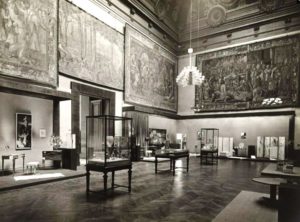
An official decision was announced as to the Palais’s future, that it would become an industrial design museum, which opened on 19 December 1895. Henceforth, it was home to regular exhibitions that attracted a public keen to discover this new form of art. In the early 20th century, art as applied to industry was seen as inferior to the major art forms of architecture, sculpture and painting. The writer-historian Maurice Quentin-Bauchart lobbied the City of Paris to program industrial design exhibitions at the Palais Galliera. Two exhibitions were organised each year: one in the autumn, covering all aspects of industrial design, and the other in spring, devoted to the work of a single artist or particular subject or theme.
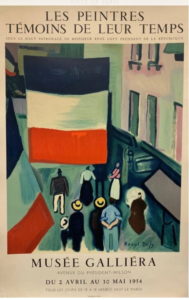
1954 brought the first of the annual Peintres Temoins de Leurs Temps (Painters Bearing Witness to Their Time) exhibitions in a Palais Galliera now recently refurbished and better suited to presenting works of art. The great artists of the time were on show there, such as Utrillo, Rouault, Matisse, Chagall, Picasso, Léger, Braque, Dufy, Kisling and Gromaire. Each exhibition had its own theme, always relating to humans and their environment: ‘People in the City’ in 1954, ‘Bread and Wine’ in 1965 and ‘The Life of Things’ in 1973. Only figurative artists were invited to exhibit.
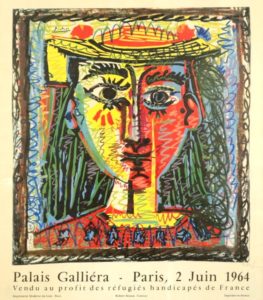
The Palais Galliera also served as a venue for auctions from 1960 onwards. Under the terms of an agreement with the City of Paris the Compagne des Commissaires-Priseurs de Paris (the Paris auctioneers association) had the right to hold sales there for 2 weeks every auction season. Only period furniture, curios and old masters were offered for sale.
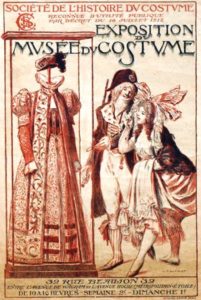
In December 1920, the Société de l’Histoire du Costume (SHC) donated its remarkable collection to the City of Paris, and while searching for an appropriate venue that would meet the society’s demand for a municipal costume museum, the City loaned the gift—some 2,000 items—to the Musée Carnavalet. This meant that only a tiny part of the collection was on show in just a few rooms.
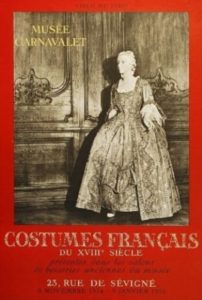
After WW2, there was a steadily increasing interest in historic and contemporary costume, which confirmed Paris’ status as a world capital of fashion, but various projects for a permanent museum came and went. A temporary home was found in the early 1950s at the historic Cercle Volney. The huge success of the first exhibition at this venue triggered the City’s initial financing of a costume museum, and in 1954, several rooms at the Musée Carnavalet were renovated and devoted exclusively to presenting the SHC’s collection.

With enormous public enthusiasm and as gifts began pouring in, it soon became clear that a more adequate venue was required. In 1956, the museum became an annexe of the Musée Carnavalet at the Musée d’Art Moderne. Unfortunately, in 1971 this museum was forced to close when its ceiling collapsed. After transferring the collection back to the Musée Carnavalet, the City of Paris decided that its new home would be the Palais Galliera, since it already owned the building.
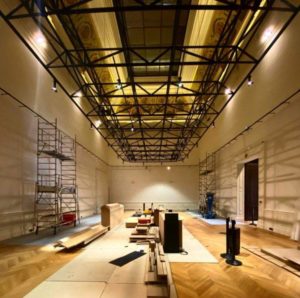
After numerous restoration projects, reorganisation and expansion of exhibition and conservation spaces, the addition of a library and archives, plus a couple of name changes, the Musée Galliera finally became the Palais Galliera in 2013.
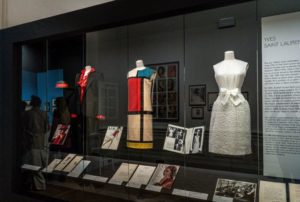
One of the glories of the Palais Galliera is its haute couture collection. Comprising over 7,000 labelled items from some 30 different designers, this is one of the largest, most representative and exhaustive collections of its kind in the world—and a perfect reflection of the diversity of the Parisian couture houses: Dior, Balenciaga, Chanel, Grès, Carven, Fath and Balmain from the 1950s, which were the forerunners of Yves Saint Laurent, André Courrèges, Paco Rabanne and Pierre Cardin in the 1960s.
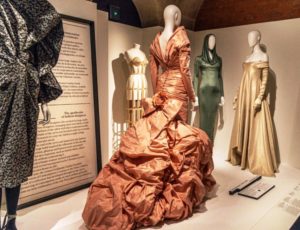
As prêt-à-porter (ready-to-wear) gradually took over from couture in the 1970s—and this trend continues into our own era—the Palais’ collection provides a graphic illustration of the creativity of more recent times, with highlights including garments by Christian Lacroix and John Galliano for Dior. The many evening gowns, worn for galas, balls and premieres, are the symbols of haute couture that fuelled the imagination of designers and an eager public. At the same time, daywear was more discreet, yet elegant, showing the technical perfection of what haute couture really is.
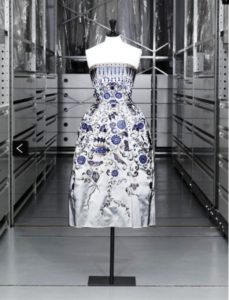
The collection began during the 1950s with donations by haute couture clients, sometimes in the form of donations as tributes to a wife or mother. In 1977, donations were received from the Duchess of Windsor, the Duchesse d’Orléans, Baroness Rothschild and Princess Grace of Monaco.
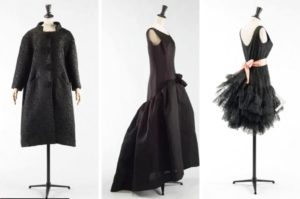
Gifts from the leading couture houses, which were keen to see their work preserved for the future, included Cristobal Balenciaga, who gave the Galliera prototypes from his most recent collections, as well as Yves Saint Laurent and Givenchy, whose gift included items from Audrey Hepburn’s wardrobe.

In 2014, the Palais Galliera hosted the first Paris Vogue Foundation Gala, held to support and promote the creation of contemporary fashion. The most prestigious French, Italian, English and American fashion houses participated: Azzedine Alaïa, Balenciaga, Balmain, Burberry, Carven, Céline, Chanel, Chloé, Dior, Fendi, Giorgio Armani, Jean Paul Gaultier, Jil Sander, Louis Vuitton, Prada, Ralph Lauren, Valentino, just to name a few. The event raised an enormous sum of money, and in addition, 53 fashion items and accessories, plus photographs and illustrations were donated.
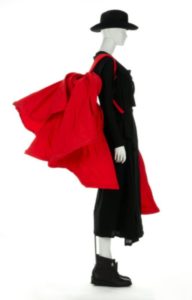
A Gala has been held every year since, with many garments donated from fashion designers such as Comme des Garçons , Martin Margiela, Yohji Yamamoto, Christian Lacroix, and importantly, the acquisition of an haute couture gown from Jeanne Lanvin’s 1936 collection and a couture gabardine dress from the 1965 Courrèges haute couture collection, both regarded as iconic pieces of their respective eras.
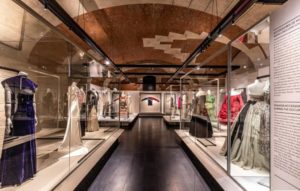
In 2019 a new ambitious project began, called the “Salles Gabrielle Chanel”. In its desire to be associated with the destiny of the Palais and as its exclusive sponsor, Chanel has contributed, along with the City of Paris, to financing the creation of these new galleries. They now occupy the museum’s vaulted cellars, which have been transformed into exhibition rooms, as well as the installation of a second vertical circulation with an elegant staircase linking the two existing levels of the building, thus doubling its surface area.

The Palais Galliera can now present larger, temporary exhibitions and display its permanent collection. The visitor experience has been greatly enhanced, with the creation of a bookshop on the ground floor and a workshop for educational and cultural activities on the lower, garden level along with additional new galleries that explore the history of fashion from the 18th century through to fashion up to the present day. There’s a very interesting section on how the fashion world adapted to shortages and austerity measures during wartime with creative innovations and substitutes.

In addition, during the building’s closure for these works, 5,000 sq.m. of its magnificent façade were restored as well as the replacement of badly weathered balconies, balustrades and colonade repairs. After a closure of 2 years, as of 02 October 2021, we can now discover all the treasures of the Palais Galliera in this exciting new chapter of its life.

To celebrate the re-opening of the Palais Galliera, a major exhibition, a Chanel Retrospective, on the life and work of the designer titled ‘Gabrielle Chanel – Manifeste de Mode’ (Fashion Manifesto) took place in the newly created Salles Gabrielle Chanel from October 2020 until March 2021.

Comprising over 350 pieces from the Galliera’s own collection, Chanel archives and international museums like London’s Victoria & Albert, the De Young Museum in San Francisco, the Museo de la Moda in Santiago de Chile, the MoMu in Antwerp, and of course from private collections.

Timed to coincide with Paris Fashion Week, needless to say, the exhibition drew enormous crowds right up until its very last day.
How to get there: The Palais Galliera – Musée de la Mode, is located at 10, Avenue Pierre 1er de Serbie, in the 16th arr. The nearest metro is Iéna, (Line 9), and a number of buses such as the 82, 72 and 32 pass very close by. The Palais Galliera is a 2 or 3 min. walk, about 800m, from the Palais de Chaillot at the Trocadero, 250m from the Musée Yves Saint Laurent, and 350m from the fabulous Musée National des Arts Asiatiques Guimet.
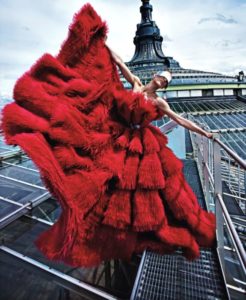


Oh WOW ! Worth a visit next time .
Hi Lois,
Oh yes, ABSOLUTELY! Graham and I are off to Paris this coming Friday, and although the Chanel Retrospective has finished, I am very keen to see how the renovations that included the former cellars has turned out. As a heritage conservation architect, Graham is also eager to see it too–and he also loves fashion! I’ve been to the museum in the past, but visiting it was always a bit hit ‘n miss, as it was only open when there was a special exhibition. Aside from anything else, it’s a beautiful building and in a most interesting part of the city that most visitors probably never get to. As I mentioned in the story, among other treats, the YSL museum is just a few minutes away, so you can have a real fashion overload all in one day! I’ll have quite a few interesting stories to put together when we’re back home at Easter. Cheers, Cheryl